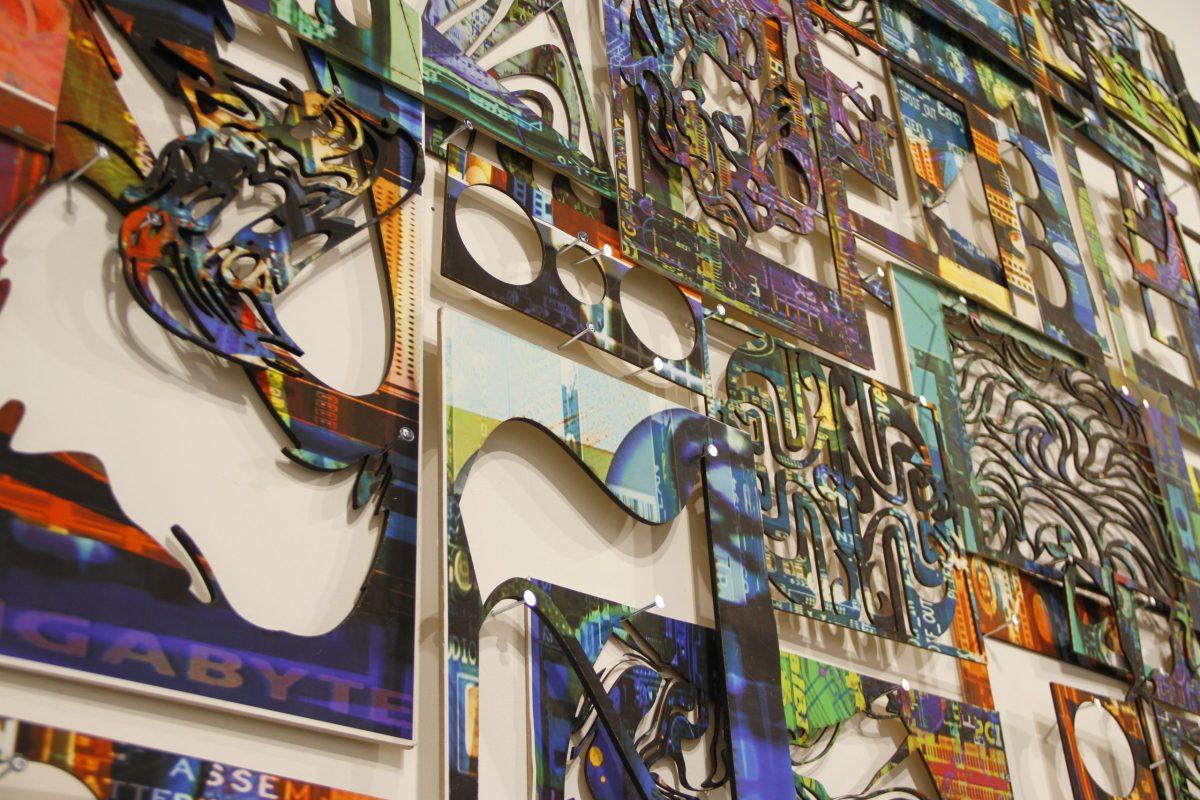
Pieces featured in the collection rely heavily on technology and digital trends. Photo by Roshan Khichi | Mercury Staff
Perhaps the most striking sight when one enters the
“Alumni_2: Inter-play” art exhibition is a haphazard array of burnt tree trunks
and sticks arranged in a wheelbarrow, all splashed with streaks of colorful
paint. Upon closer inspection, one notices a framed picture of an old woman
hung on the wall above.
This is UTD alumna Jennifer Jones’s artwork, a memorable
piece documenting her grandmother’s journey with dementia, and it sets the tone
for the rest of the exhibition: a modern collection that deeply explores the
human psyche.
Jones said that her piece came from a “dark recess” in her
mind and blossomed when she figured out what to do. It represents her grandma.
“Back in her days … she was raised not to share a whole lot
of drama or anything. We’re kind of piecing things together, but we can’t find
out anything from her anymore, because she doesn’t remember anything,” Jones
said. “I just wanted something bright that stuck out — really colorful, because
that’s kind of how I perceived my grandma before everything took over her
mind.”
The exhibit ran from Oct. 25 to Nov. 23 in the Synergy Park
North 2 building. Curated by John Pomora, a professor of Visual Arts, the
exhibition featured artwork from 20 UTD undergraduates and graduates. Various
mediums included videos, collages, paintings and digital sculptural
installations. Each medium is transformed to fit the artist’s narrative:
digital artworks toed the line between artifice and humanity, paintings printed
with digitally-fabricated surfaces distorted the idea of imperfect creation,
and 3-D artworks dangling from the ceiling explored individualism through
collages.
Upon entering the main room of the gallery, the viewer is
immediately greeted by a collage of multicolored technological frames. “Fragments
of Technological Expression” by Denise Lion delves into the rapid,
ever-shifting nature of technology and its relationship with humans. Each
metallic frame appears to oscillate between varying shades of blues, greens,
pinks and reds, with many frames’ outlines crisscrossing to form pictures.
Pomora said that the former dean of the School of Arts and
Humanities Dennis Kratz asked three of the Arts and Humanities faculty members
to curate alumni shows in celebration of UTD’s 50th birthday.
“I’ve decided to include a broader range of people, but more
focused with painting and video, as well as some digital photos,” Pomora said.
“I’m a big believer in video art, so I wanted to showcase as much of that as I
possibly could. I also wanted to include some of the painters that weren’t
included in the first show, as well as some of the digital imaging people that
were also more recent graduates.”
The exhibition relies heavily on technology. In “Hashtags,”
crafted by Heather Charlet, multiple digital installations are arranged
side-by-side, their flat screens switching rapidly between multiple Instagram
hashtags. One, labeled #pranked, features posts of prank videos and how-to’s.
Another food related hashtag yields photos of trendy cafes, tropical fruit
smoothies and people gorging themselves with snacks. One set of photos depicts
the aesthetic of a lonely, antisocial individual, including a selfie of a
sullen, pale youngster looking down at the camera.
Other digital pieces include Hillary Holsonback’s chilling
short videos of a young, heavily made-up woman, Tan, who often stares into
space, occasionally glitching out of frame. The vivid coral colors that the
woman wears distinguish her against the muted backgrounds, so that all
attention is focused on her. When her figure flashes and disappears from the
frame, the viewer is jarred — it is almost akin to watching a horror movie.
Pomora said that
though he had run out of room when curating the exhibition, he thought that the
exhibition had a cohesiveness to it.
“We had to consider … what really looks good next to
something. That’s something that’s really important: when you put a painting
and then a video next to it, you have to think also about the sound. Is this
sound going to affect the paintings that are right next to it?” Pomora said.
“We thought very much about where things were hung and how they related to the
pieces next to them, so we tried to hang things that looked good next to each
other that could have a conversation with each other.”
Pomora said that the show included both international and
regional students and that it was healthy in its diversity.
“Creative art is about expressing yourself in the way you
see the world,” Pomora said. “It just shows, I think, a really interesting
mixture of diverseness and how diverse creativity really is, and how it
reflects students from different cultures and their ideas about the world and
how they see it.”